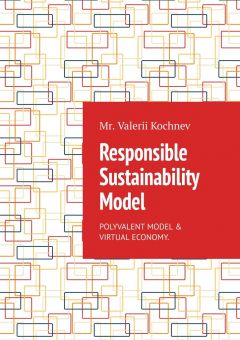
Автор книги: Mr. Valerii Kochnev
Жанр: Философия, Наука и Образование
Возрастные ограничения: +12
сообщить о неприемлемом содержимом
Текущая страница: 3 (всего у книги 19 страниц) [доступный отрывок для чтения: 6 страниц]
7. Principles and forms of implementation of green sustainable development
Principles of green sustainable development:
The Green Goals and the Sustainable Development Goals are identical to indicators of a comprehensive vision of the problem of sustainable development and indicators of global sustainable development.
The philosophy of the components of green sustainable development and a common basis for mobilising the launch of global change.
The philosophy of the components and the basis for mobilising all the changes necessary to achieve the final goal.
Mobilising change components and foundations to achieve the ultimate goal of green sustainable development.
In practice, each green and sustainable development goal in isolation is often viewed as «a good idea, but not achievable» and therefore all future plans are regarded as secondary, even the most ambitious. The Green Goals and the Sustainable Development Goals, on the contrary, are an integrated and interdependent whole that is a reality for all of us, and therefore achieving this set of goals is not impossible, but the only way to ensure progress in the real World.
The UN has documented the goal of sustainable development as «development that meets the needs of the present without compromising the ability of future generations to meet their own needs.» This concept has been applied to all areas of human activity and the planning of development projects has become more complex, taking into account the interconnectedness and interdependence between all aspects of life.
To ensure green and sustainable development in today’s world, innovative programs must adopt new forms of organisational structure, as well as new methods of implementation. It is clear that the realisation of great achievements in various sectors of Green and sustainable development can only be achieved by the joint efforts of all in the future. There is a strong connection between each of us and the environment and nature. As for the media and the Internet, they have a very significant impact on the world. In order for the masses to understand the meaning of Green Sustainability, the media and the Internet can convey the positive message of Green Sustainability.
These efforts will only be rewarded if everyone can put aside their personal interests and can think of themselves as part of a larger whole.
Only through the development of such enterprises will people value themselves, the environment and the Earth more.
8. Polyvalent model. Essence. Characteristics
In the modern competitive environment, a number of issues are acute that relate to the safety and security of investments, communication and implementation of products of other similar projects in a single environment, as well as the demand and prospects for a wide range of applications in the material economy, growth and development forecasts, including in the stock market.
A platform for a variety of diversified industries can respond to such requests within its system as a polyvalent model for their interaction. The polyvalent model is a reaction to objectively prevailing conditions, which allows projects from different industries to successfully function together, as well as simultaneously develop further through the use of existing innovative technologies and new philosophical ideas in combination with each other. The purpose of the polyvalent model is to create a universal framework for facilitating the implementation of initiatives related to green and sustainable development through a series of large-scale projects aimed at developing green and sustainable sectors of the economy, and its main emphasis is on the integration of the social and economic spheres of the economy to create an environment in which the results of the development of components and applications will contribute to the formation of a positive attitude towards the environment, the development of various sustainable initiatives, the assessment of their environmental impact and the monetisation of these initiatives and materialise when used as a basis for bringing together people who share similar goals for development green sustainable development and community. The polyvalent model will provide many opportunities for implementing projects of various sizes and will include both small initiatives at the local level and large-scale projects at the global level.
Such a polyvalent model in the process of development generates new directions within itself, attracts third-party opportunities, responds to new challenges as they arise, may involve the use of cross-technologies, the development of joint algorithms that are effectively implemented in the external environment, building interactions with third-party innovative projects, in different degrees of integration, as well as other advantages for achieving sustainable development goals.
It is important to note that the polyvalent model has the following characteristics:
First point. Innovators (novelties) make up a large percentage.
Second step. Obviously, it is carried out in a variety of industries.
As a third. Synergy exists between several aspects and components.
Four. There are a number of different areas of development inside.
An important characteristic of the polyvalent model is the constant growth of complexity, as well as internal dynamics, including the evolution of existing components, the emergence of new ones, the creation of new relationships, the establishment of new directions for development. There is no doubt that the more complex the model, the more development options, the higher its efficiency, the more profitable it will be. A polyvalent model that takes into account all events that can be foreseen and affect future development creates an opportunity for growth and increased profits.
The polyvalent model is a wide variety of synergies (interconnections), which allows the use of components and components in several different segments, each of which has its own value.
The polyvalent model is characterised by a high level of novelty and flexibility, which contributes to the creation and development of new new applications, in which the variety of possible changes and combinations is comprehensive and qualitative, and a wide range of design changes and combinations can be identified.
9. Social responsibility. New forms of development
The activities of polyvalent models at the initial stage of development should be focused primarily on the critical path that contributes to the development of the human body, including thinking, action and feeling. When people can touch and feel the benefits of polyvalent models, they will unconditionally be convinced of their significance and value. When people’s education begins, it should focus on the following areas:
Encouraging people to develop a strong sense of social responsibility and self-worth. Once people develop a sense of social responsibility, they will be more willing to contribute to the development of the social and economic environment, the protection of the environment, and the protection of the Earth.
The second direction is focused on the development of the body and physical self-realisation.
While the main goal of the polyvalent model is to raise awareness among the general population of the importance of a green and sustainable enterprise, an inevitable side effect is that the polyvalent model can also serve as a guide for those involved. It is very important for everyone to emphasise and ensure that sustainable development is the most important foundation of all development projects. Sustainability is difficult to achieve, but it is worth doing and making every effort.
An opportunity for many people to participate and contribute to the solution of the global problem of ensuring green and sustainable development on a global scale, having enlisted the financial and legal support of a polyvalent model, thereby achieving material well-being on a global scale. It is an image of a prosperous society, made up of people who innovate in a wide variety of industries, people who advocate a new philosophy and use new technologies to create a common space of like-minded people who practice the new realities of everyday life.
One element that needs to be developed is the awareness of social and ethical responsibility as a basis for the successful implementation of policies and operational plans. Therefore, it is clearly emphasised that proper awareness and ethical standards are an essential element of a multivalent model, be it a national project, a private sector enterprise, a public-private partnership, to provide a stable basis for all macro-level decision-making in the overall green development process.
A polyvalent model as a tool for the idea of sustainable development and a means of attracting the attention of people and society to the value and the most important message of sustainable development, as a means of changing the perception of public attitudes, attitudes and behaviour of each person towards understanding the most important message of the concept of sustainable development and the close connection of each of us with sustainable development as a means of changing the perception of the place and meaning of a polyvalent model in the field of sustainable development.
As a means of communicating people with the message of sustainable development, as a means of generating a strong public interest in a better understanding and positive perception of the concept of sustainable development, as a means of personalisation, individualisation and concretisation of the concept of sustainable development, the concept of the place and meaning of a polyvalent model in the field of sustainable development.
There is one very important feature of this polyvalent model that should not be overlooked. There is no doubt that this is an example of how «green sustainable development» can succeed. In the traditional sense, this does not refer to technology as it is understood today. It is the process of taking an idea to the global level and ensuring its development. It refers to the process by which an idea develops at the personal level of a person.
The process of developing an idea at the level of each individual family to make it work. An individual is a concept that develops from the ideas he or she has about himself.
As a result of the unique characteristics of the environment, each region develops its own ideas based on these characteristics. The idea of each country is developed as a result of its own development. The idea of the world develops in the process of globalisation. It is the process by which the idea of society develops. The development of the idea of the environment is part of the development of this idea. The development of the idea of green sustainable development is about the development of the idea of the world, the environment and society, the idea of the environment, the development of the environment, world development, the development of the universe. People have the right to celebrate the achievements of science and technology. Every year new technologies are developed and new scientific discoveries continue to be made. The Internet has the potential to develop and change the world. There is a process of using technologies for development, which will lead to the development of existing technologies and the emergence of new technologies. It is the process by which the idea of development creates the image of development. This is the idea of the future.
The idea of production is also the idea of the future. It is the realisation of the development of the ideal of the environment.
The idea of the future is developing. This is the implementation of the environment. This idea can be called «image of the future».
We all know that in our time, we are constantly under attack from various materialistic concepts that are portrayed in the media and on the Internet. However, the uniqueness of the polyvalent model lies in the fact that it can be used to reinforce the concept of «green sustainable development».
The introduction of the concept of «green sustainable development» is an extremely important milestone in the development of human society. The concept of «green sustainable development» is, first of all, the concept of the environment and nature.
If we look at this from the point of view of a general theory of personal development, we will see that this is a new look at the concept of personal development.
It is clear that any idea, regardless of its impact on the environment, has a profound impact on the environment. The environment can be a driving force, a value for all ideas, regardless of their impact on the environment. This, in turn, can stimulate the implementation of these ideas, contribute to the development of the concept of the environment, and in such cases, the concept of the environment can be conditioned by the concepts of nature, which directly contribute to the development of the concept of the environment.
10. Systems and architecture of interaction with an individual
Ideas about individual and family development are directly related to the general understanding of the idea of the environment. In this case, the process of developing ideas about the individual and the family is much more complicated than the process of developing ideas about the world.
At the physiological level, emotions are feelings, feelings as causes, actions, and effects, which are the simplest physical and chemical reactions available for digital processing. At the same time, it is a huge universe of infinite information, which is defined as a set of the simplest physical and chemical reactions.
The polyvalent model aims to provide an interpretation view and predict the behaviour of individuals and groups in the context of the perception and interpretation of the information environment in which they are constantly involved, as well as to recognise, interpret and predict behaviour. The structure of each living organism is characterised by the presence of endomorphic and ectomorphic systems, each of which performs two main functions: the formation of perception and assessment of the current situation. Due to the endomorphic system, emotions are generated, as well as sensations and stimuli are generated. As a result of cognitive processes that are carried out by the endomorphic system, all reactions to external stimuli are carried out on the basis of the data received from them.
Like any task, it consists of three main components: information, a problem, and a solution chosen for the task. Any change in one of the components of the system will lead to changes in other components if the change occurs in one of them.
As a starting point for creating a collaborative program, each model and problem needs to be analysed with a set of methods and tools that will help highlight the main components of the problem and their interrelationships, as well as the interactions between them.
A single program of a polyvalent model, which will use data mining methods in the field of computational intelligence, will be able to combine the individual components of the problem. Another method is the use of neural networks, which are especially useful in this case, since they are able to process huge amounts of information. Their implementation in the work will be divided into two parts: data input and output, which will be performed independently.
The inference method will produce an inference about the behaviour of individuals and groups under various circumstances, while the input method will provide data and information about the state of the individual or group, the quantity and quality of which can be changed by the course of events, and the content of which is often difficult to assess.
The polyvalent model develops a system that can receive information and analyse it as a result of the operation of a neural network, and then create a decision-making system.
All cognitive system models can be divided into two categories: models that separate problem and solution, and models that combine problem and solution. Both categories have their advantages and disadvantages. The advantage of separating the problem and the solution is the ability to identify the external and internal conditions of the problem, which are important for understanding the factors that influence the behaviour of an individual or group. The disadvantage is the difficulty in understanding the relationship between the problem and the solution, which also affects the behaviour of an individual or group. In a unified approach, the problem and solution are combined into one, but this limits the ability to understand the relationship between the problem and the solution. In both approaches, it is important to identify the main components of the problem that determine the nature of the problem. The first type of analysis is designed to separate the components from the environment and from the observer, and the second type is to separate the components from the external environment.
The problem of establishing the effectiveness of cooperation is characterised by the fact that it is possible to cooperate with a person whose origin, culture and cultural reference points do not differ from the situation under consideration. It is very difficult to establish communication with such a person, and, as a result, cooperation is established with great difficulty, if at all.
The problem of establishing the effectiveness of cooperation is a key problem for most areas of human activity and is a necessary foundation for building any human activity.
The uniqueness of the method of analysis and evaluation lies in the presence of a computerised component in the development of the cooperation system. The architecture is based on the use of artificial intelligence tools. The task is to create a system with the following characteristics:
1) The system will be integrated into the information environment of the participants in the cooperation process.
2) The system of cooperation will not be static.
After the analysis, the desired goal of the system can be formulated. This goal will help find a solution to the current problem. A set of tools and methods is also needed to prepare a program of interaction with the system, which will change the parameters of the solution of the problem in order to achieve an increase in efficiency.
The main result of the developed cooperation program will be a change in the parameters for solving the problem. As a result, this will lead to a change in the values of the parameters, the end result of which will be a change in the behaviour of the system.
To achieve this goal, it is necessary to identify all the components that make up the system. Endomorphic and ectomorphic systems are two independent systems that are part of the information environment. From a technological point of view, these two systems are represented by interfaces that are designed to create a combination of these two systems into one system.
In other words, a set of methods and tools is created to isolate the main components of the problem and their relationships, as well as the interactions between them, which will determine the solution to the problem.
The purpose of a polyvalent model is to develop methods and tools for analysing dynamic systems, creating models and extracting them from existing models, creating tools for forecasting and creating systems for coordinating a team of experts. The polyvalent model is designed to be applied to the analysis of any problem that requires the interaction of specialists and the creation of various options for solving the problem.
11. Collective mind. cognitive systems. Information and Communication Technologies
The polyvalent model is aimed at creating a modern service for the prevention and prevention of violence of various kinds, in order to ensure the well-being of children and adults, as well as the development of the country and the world as a whole, for the sake of a beautiful, healthy, strong and healthy life for children and adults. To create a healthy and peaceful society, an integrated approach is the first step towards a bright future, the formation of a healthy way of thinking, action, communication based on moral and ethical standards, compliance with the law, protecting the environment, caring for the future of children is an integral part of this process based on and development new social science of the 21st century about the collective mind of all systems. The collective mind of all – cognitive systems – is a complex adaptive system in which natural and artificial processes of evolution and development interact to create knowledge and wisdom.
The collective mind of all is cognitive systems, a new scientific and technical direction capable of solving the most important tasks of mankind: the study and development of artificial and natural living systems, the creation of a holistic artificial «living» model of the Universe, the main mission of which is the development and implementation of the spiritual world, the creation of new forms public relations, the development of culture, economic and political life, the creation of humanism.
The development of a new scientific and technical direction of cognitive systems and cognitive agents, which are an integral part of artificial intelligence, will create flexible and highly efficient production in the economy in human and non-human senses, the introduction of systems in various areas of life, the development of quality services, the creation of new business areas and the emergence of new business models, the development of artificial languages for information processing, the development of cognitive systems for computer graphics, computer animation, literary, musical and artistic works, the creation of a new generation of software systems and the creation of a new generation of robotic platforms and systems.
The creation of cognitive systems, cognitive agents and cognitive robots, which are an integral part of artificial intelligence, is a new scientific and technical direction in the development of artificial intelligence, cognitive modelling, cognitive computing.
In the field of psychology, cognitive psychology is the branch of psychology that studies mental processes such as «perception», «learning», «attention», «memory» and «language». In computer science, a cognitive system is a system that exhibits the characteristics of intelligence, cognition, or consciousness. Cognitive systems are very different from «robotic systems». Cognitive systems are developing as a new scientific and technical direction. The study of cognitive systems is a new scientific direction in which various disciplines are involved.
In cognitive systems, the direction of scientific and technological progress involves the development of a new type of artificial intelligence based on the use of artificial neural networks and genetic algorithms in a new scientific and technological direction – cognitive systems. Cognitive systems are the culmination of scientific and technological progress of the twentieth and early twenty-first centuries in the field of artificial intelligence. Cognitive systems are already highly developed in Western countries, especially in the USA, where this industry is developing.
The creation of cognitive systems is the most important component of the socio-economic development of the country, the basis for the creation of artificial intelligence, robotics and space systems, the basis for the creation of new technologies.
The cognitive system is the basis for the creation of a new industry, new technology, the creation of artificial intelligence, software, new robotics, the creation of new economic and social systems, new technologies, new environmental and new computer technologies.
The creation of cognitive systems is one of the most important areas of science and technology, industry and economics, as it is a new form of science and technology, industry and economics, which significantly changes the entire technological and scientific process, the nature of production and social relations, the entire management system and politics, the entire system of education and culture. Promotion of a polyvalent model of green and sustainable development and new cognitive systems using ICT, a program to promote a polyvalent model using ICT are the basis for the formation of a positive perception among the population, and the practical application of monetisation through an integrated system of green sectors and sectors of sustainable development.
At this stage, the goal is to develop the first phase of the «Emotion Meter» based on a new ecosystem using the «Emotion Sensor», i.e. an information consuming device that uses a sensor with a unique software algorithm that determines the emotional reactions of users to changes in their voice, facial expressions and body movements, and thereby develops a new business model through a system that records users’ emotional reactions to various information and tags them with a social index, linking emotional reactions to user data. The positive perception of the population is based on a complex system of relationships between people and families through the contribution of these people and families to the development of society. The family is an institution whose main task is to provide conditions for the formation and development of the child, as well as to ensure his further education for further development in society. In this regard, there is a need to develop and promote a program to optimise relationships between family members, to provide the necessary conditions for the formation and development of a child from the very beginning of child’s life.
A child is a young person who actively participates in the formation and development of society, but during adolescence, child’s development is largely determined by parents and teachers. In order for the child to have a good time at this stage, it is necessary that parents and teachers organise their work correctly and effectively.
Here are the most important things to remember.
The goal of the polyvalent model should be achieved through instrumental approaches, the goal is the intrinsic value of the model itself, which is a single comfortable space with branched horizontal connections, a system of incentives aimed at encouraging a more responsible attitude to life, a conscious approach to the choice of goods and services that meet the requirements of various sectors green and sustainable development.
There is nothing more complex than a polyvalent model in terms of ideas, concepts, options and implementation approaches, ways to implement the individual steps leading to a successful polyvalent model. Any polyvalent model requires a certain amount of financial and intellectual investment.
The polyvalent model can be started from the moment the community is formed and the corresponding community is created to launch the polyvalent model based on a private company or civil society organisation that is part of the community. The creation of a new company or the development and promotion of an existing company are just a few examples of the start of a polyvalent model.
You can start developing a polyvalent model project by creating a social community that will implement the polyvalent model. Development of a polyvalent model that will open the minds of the people involved in the model, thus gaining a lot of interest in marketing it to the outside world and using the polyvalent model in various ways for leadership in the field of green and sustainable development.
Using a polyvalent approach to socio-economic development as a specific mechanism for transforming society, as well as introducing a new type of social responsibility and a humane approach. This can be a common denominator for all entrepreneurs, private investors and everyone involved in the process of building a sustainable economy. Growth is a social function, and the polyvalent business enterprise promotes a value system, a systematic approach to formulating growth strategies. Promoting a quality form of life, focusing on a system of tools for building a new model of economic relations based on the development strategy approach as a social goal. Instead of a profit-for-profit approach, business entrepreneurs, investors, and everyone involved can be motivated by a positive attitude towards universal human values.
The model strongly influences the development of mankind. Each person must be responsible for his actions, since each person is a part of society and his actions affect society as a whole, where each individual follows the goal of a common idea. The idea of a polyvalent model is a free and democratic basis in which team members have equal rights and participate in the activities of a polyvalent model in accordance with their abilities with identical rights and opportunities for all members. The basic condition for membership is the desire to create a better world.
Правообладателям!
Данное произведение размещено по согласованию с ООО "ЛитРес" (20% исходного текста). Если размещение книги нарушает чьи-либо права, то сообщите об этом.Читателям!
Оплатили, но не знаете что делать дальше?








































